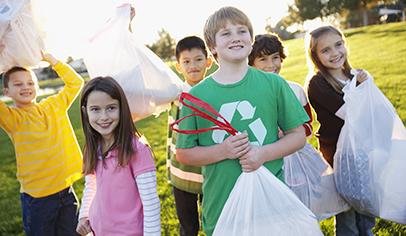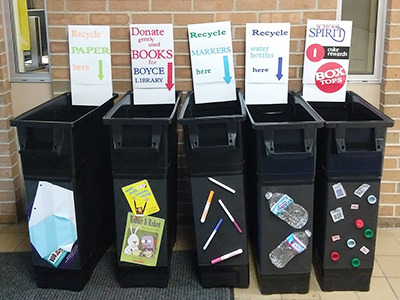How PTOs Are Making Schools Green

PTOs and PTAs are increasingly playing a key role in school efforts related to recycling, composting, and reducing energy use.
In addition to building parent involvement and supporting school programs, parent groups are increasingly taking on another role: trying to make their schools more environmentally conscious. Many groups work to raise environmental awareness among their school’s students. Some have gotten into recycling in a big way. Others create compost piles that provide soil for school gardens. The transformations are limited only by the imagination of parent group leaders, who usually start by creating a green committee to deal with these issues.
Becoming a Green School
The PTSO at Caroline Street Elementary in Saratoga Springs, N.Y., had been receiving a lot of comments about waste. “One concerned how much plasticware there was in the cafeteria. Others were about the volume of paper coming home,” says copresident Jennifer Cholnoky. “It seemed to make sense to approach all those things under one committee and make some positive changes.”
Caroline Street is an example of how parent groups have found themselves increasingly involved in environmental issues. Addressing one concern among parents leads to investigating others; the result is that many groups have taken a leadership role in efforts to reduce waste and minimize the impact on the environment. “We’re doing what we can to be more mindful of the planet,” says Ruth Oxenberg, PTA president at Mill Road Elementary in Red Hook, N.Y.
Join the PTO Today community (it's free) for access to resources, giveaways and more
One of the most important first steps is awareness, especially among students. Ladera Elementary in Tustin, Calif., promotes Walk to School Wednesday. Once a month on a randomly selected week, students on the “green team” give a charm and a sticker to those who walk, bike, or carpool to school.
The classroom with the highest participation receives a “trophy”: an artificial tree on which a leaf is glued with the winning classroom’s name. The green team also meets three days a week during morning recess to collect paper from classrooms for recycling.
The science fair at Wayne Elementary in Pennsylvania has a green theme this year and includes suggestions for projects like analyzing the family garbage. Daily school announcements provide information such as how many plastic bags go into the ocean every year. One teacher is trying to fill a janitor’s closet with bottle caps, which are not recycled by the township; the teacher will create a mural from the caps. “We’re collecting them to show kids how this one thing accumulates, how little things add up,” says Heather Block Reilly, cochair of the PTO’s green committee.
In recent years, some parent groups have purchased water bottle filling stations to encourage students to use reusable water bottles at school. Many plastic water bottles end up in landfills rather than being recycled, so when students fill reusable water bottles at the filling stations it can reduce the number of plastic water bottles thrown in the trash.
Finding a Focus
One challenge for environmentally conscious parent groups is to identify an appropriate focus area. Wayne Elementary’s green committee initially looked into selling reusable grocery bags and water bottles but decided that it was not a real need at their school. “It’s taken us six months to get clear on what we’re going to do,” Reilly says. “We picked a couple ideas to see what flies.” One project they selected aims to beautify the environment as well as help children recognize its value. They teamed with the National Audubon Society and a local environmental protection group to create habitats of native shrubs and trees and to purchase 30 backyard bird-watching kits for classes to use.
At Mill Road Elementary, the green committee focused the first year on recycling bottles and cans. This year, explains chairwoman Laurie Husted, “we decided that recycling wasn’t enough. We wanted to take it a step further to do prevention.” That was easier said than done: “A big part of the battle is finding the right product,” she says. Finally, the group found a reusable sandwich and snack wrap and reusable water bottles, which it offered for sale.
Changing people’s behavior can take some coaxing, too. To get families to bring their own silverware to school events, the Peterborough (N.H.) Elementary parent group offered a ticket for a free baked good or popcorn. At a recent event at Seward Montessori School in Minneapolis, coordinators sold water in compostable cups; when people brought those cups to the composting station, they got their money back.
Changing school processes can be even more difficult, often for reasons beyond a parent group’s control. For example, Wayne Elementary still uses foam trays in the cafeteria despite parents’ concerns because of contracts with suppliers. Sanitation may also be a consideration—the PTA at Old Settlers Elementary in Flower Mound, Texas, wanted to reduce cafeteria waste by introducing reusable trays, but it wasn’t feasible. Before suggesting any changes, research possible limitations as well as alternatives.
Recycling
Often tackled in concert with reducing waste is encouraging recycling. A first step is to find out what the school may already be recycling. “I thought that of course our school recycles,” says Oxenberg of Mill Road Elementary. “But it didn’t. I was stunned.” Your school might not recycle because changing the way trash is handled is not simple. If the amount of recyclable material the school produces is small, it may be a challenge to find a company to pick it up. One solution is for school districts to act as a central collection point for multiple schools, or even for several schools to join forces. Another solution is to invite the community to help fill a receptacle if your school has the space for it but not enough material to fill it regularly.
There can also be administrative resistance to altering the waste management system. “You have to change service levels and deal with the business office of the school district and with the principal,” says Suzanne Wight Wilson, who chairs the PTO’s green committee at Hillview Middle School in Menlo Park, Calif. “And a big piece is the custodians. They’re the ones who are going to have to pick it up and fix it if it doesn’t work. Administrators don’t want you to come in and change everything and make custodians’ life difficult and then go away.”
Wilson started by asking her school’s custodian for his ideas. He suggested that two waste stations would not be enough because kids would not be willing to walk to the stations. As a result, eight stations were created despite the need for additional monitoring. Wilson serves as a liaison for issues that arise between the custodian and the waste management company. “It’s the parent volunteer’s role in this to be the glue between everything,” she says.
Recycling often involves sorting materials. If students will be recycling, it's important to make sure the system you set up is easy for even the youngest students to follow. At Boyce Elementary in Ionia, Mich., the Parent Teacher Guild labeled recycling bins and put example items on the side of each one. Bins for paper, markers, and water bottles were placed with containers for book donations and collection fundraisers.

Composting
Another green activity is composting. Mill Road Elementary has a two-tier system geared to different age groups. Students in kindergarten through 2nd grade take turns collecting food scraps for the school’s compost pile, which provides soil for a trail and a greenhouse. Students in grades 3-5 contribute their lunchroom scraps two days a week to an area chicken farmer. A parent who is already at the school for lunchroom duty drives the scraps a mile to the farm. “We’re feeding about 200 chickens,” Husted says. “If we could add a couple days, we would take away the farm’s need to buy grain. That’s my goal. But we need a few more willing bodies, and we don’t want someone to drive to school specifically to take the scraps out. Otherwise, we’d be adding carbon emissions.” To complete the cycle, eggs from those same chickens will be hatched in a classroom this spring.
Staffing lunch collection points is a common problem for composting programs. Hillview Middle School’s green committee solved the problem by using student monitors, allowing them to earn points for extra privileges such as buying dance tickets at a reduced price, moving forward in line for lunch, and getting a special jacket. The school uses an organic food service vendor and a commercial composting company. Administrators switched from plastic trays to recyclable cardboard boxes and purchases some compostable utensils. The cost of these changes—about 10 cents per meal—is passed on to the students. The result is that one-third of the school’s trash is now composted, with the end cost of removal about the same.
Saving Energy
Reducing energy use is another possible avenue for green initiatives. Seward Montessori in Minneapolis enrolled in a districtwide program aimed at reducing building energy use by 10 percent. The PTSO also enrolled in a free program offered by a local engineering firm, which sends retired engineers to assist with energy- and waste-reduction efforts. Strategies might include automatic shut-off switches on computers, for example. Representatives from a local university organization, the Center for Global Environmental Education, will speak about energy awareness at a school assembly and help children evaluate how they affect the environment. This will be part of a month of energy awareness activities and will conclude with a family celebration that has a zero-waste goal. “We will encourage everybody to bring their own eating utensils, we’ll compost organic waste, and we will put other items into trash-for-cash streams,” says Emily Green, cochair of the PTSO’s green committee. “We’ll weigh items at the end of the night to show what we generated.”
For schools and groups, the benefits of creating a culture of conservation are many, some of them quite tangible. “With the current funding crisis, recycling and reduction is a key area for schools to move into,” Green says. “Some of these measures will result in cost savings ultimately. We need to get our heads wrapped around how those tradeoffs work.”
Related Resources
Green Schools National Network
Originally posted in 2009 and updated regularly.






















